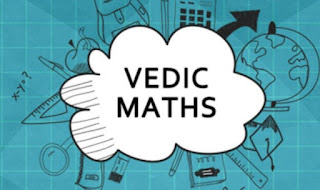VEDIC MATHS-14
VEDIC MATHS
By OMKAR TENDOLKAR
Hello friends,
This is our 14th blog from the series of "Vedic maths" blogs. Here in this blog we will learn about "Criss-Cross System of Multiplication".
Criss-Cross System of Multiplication :
In Vedic Mathematics , we have similar system as like traditional way of multiplication it helps us to get the answer much faster. This system is also universal system and can be used for any combination of numbers of any length.
This system of Multiplication is given by the "Urdhva-Tiryak Sutra." It means 'vertically and cross-wise'. The application of this system are manifold, but in this blog we shall confine our study only to it's utility in multiplying numbers. We shall call it the criss-cross system of multiplication.
Method:
Let us suppose we want to multiply 23 by 12. According to traditional system, our answer would have been:
2 3
× 1 2
------------
4 6
+ 2 3 0
------------
2 7 6
With the Criss-Cross System, we can get the answer in just one step as given below:
2 3
× 1 2
-----------
2 7 6
Let us have a look at the modus operand of the system:
Step 1:
2 3
⬇️
× 1 2
-----------
6
We Multiply the digit in unit place, that is, 3×2 = 6. We write 6 in the units place of the answer.
Step 2:
2 3
✖️
× 1 2
-----------
7 6
Now we cross Multiply and add the products, that is (2 × 2) + (3 × 1) = 4 + 3 = 7. We write the 7 in ten place of the answer.
Step 3:
2 3
⬇️
× 1 2
-------------
2 7 6
Now we Multiply the one digits, that is, 2×1=2.
The complete multiplication is:
Examples:
1) let us Multiply 31 by 25
Step 1:
3 1
⬇️
× 2 5
-----------
5
First we multiply 1 by 5 vertically and get the answer as 5.
Step 2:
3 1
✖️
× 2 5
-----------
7 5
Then, we cross multiply(3 × 5)+(2 × 1) and get the answer as 17. We write down 7 in the tenth place of the answer and carry over 1.
Step 3:
3 1
⬇️
* 2 5
-------------
7 7 5
Lastly, we multiply (3 × 2) and get the answer as 6. But, we have carried over 1. So, the final answer is 7.
Answer:
31 × 25 = 775.
Given below are a few examples of 2-digit multiplication where there is no carrying-over involved.
(A) (B) (C)
1 2 2 1 3 2
2 1 1 4 1 1
--------------- -------------- ---------------
2: 1+4 :2 2: 1+8 :4 3: 2+3 :2
=252 =294 =352
An example of 2-digit numbers where there is a carry-over involved:
2 3
× 1 4
-----------
3 2 2
- First, we Multiply 3 by 4. The answer is 12. We write down 2 and carry over 1.(The answer at this stage is __2).
- Next, we cross multiply (2 × 4) and add it to (3 × 1). The total is 11. Now, we add the 1 which we carried over. The total is 12. So we write 2 and carry over 1. (The answer at the stage is _22).
- Last, we multiply (2 × 1) and get the answer as 2. To it, we add the 1 that is carried over and get the final answer is 3.
( The complete answer is 322)
More examples:
- 17×23=391
- 14×56=784
- 16×78=1248
Thus, we see how to Criss-Cross system of multiplication helps us get our answer in just one line! And, the astonishing fact is that this same system can be expanded to multiplication of numbers of higher digits too. And in every case, we will be able to get answer in single line.
The simplicity of this method can be vouched from examples given above.
You may try following example:
1) 24 × 14
2) 76 × 46
3) 23 × 17
You may answer this in comment box. You may ask your any query or doubt in comment box. I will try to resolve as early as possible.
In next blog we will discuss about "Criss-Cross System of Multiplication for 3-digit number".
Are you excited for this?...
Then, please wait for it.
I will post my new blog in next week.
We will meet very soon through our next blog. Till that stay connected, stay healthy and stay safe.
Thanks
for giving your valuable time.
Good day😊.



Comments
Post a Comment